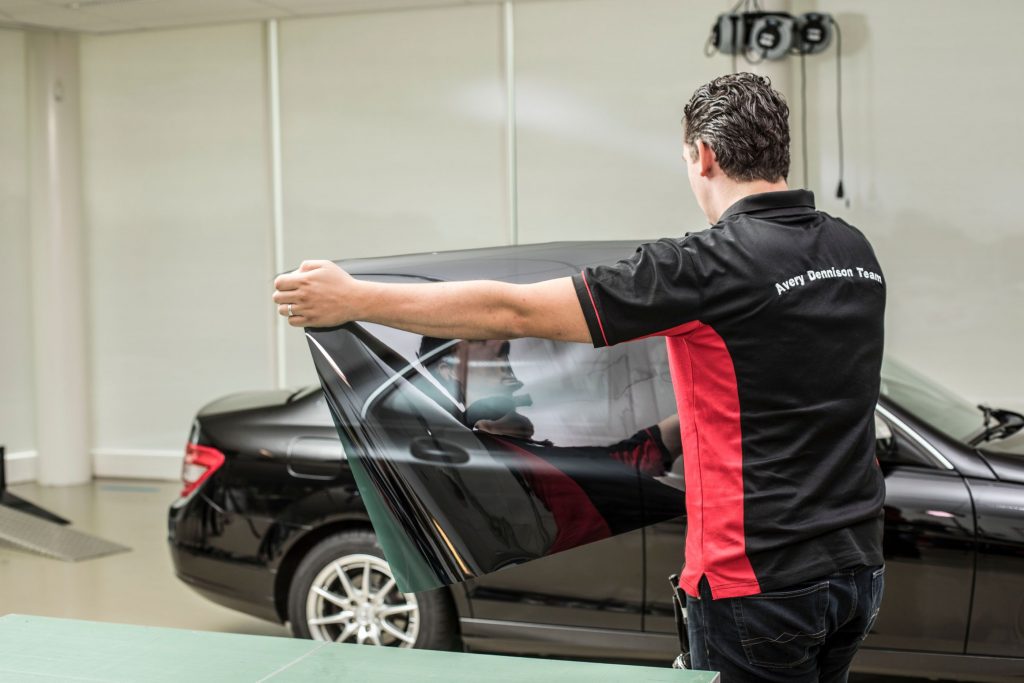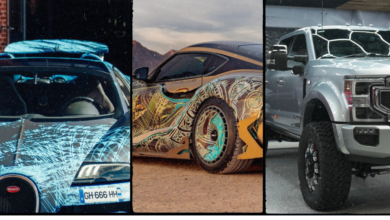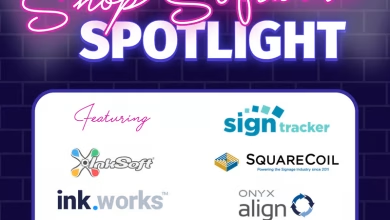Boost Your Bottom Line with Window Tinting
How window tinting capabilities can boost a wrap shop's bottom line
Windows. They can be commonly associated with characteristics such as clear, transparent, and protective. Or you may simply observe that they function as gateways to sunlight.
Sunlight. Our natural illumination source might incite other words such as a new day or warmth. This is a pretty basic lesson in vocabulary, however, it all becomes amplified in real-life situations. And it’s especially enhanced when the wraps industry gets involved.
If you’re part of the tinting business other choice phrases come to mind, such as bright or annoying glare or harmful UV rays, when referring to sunlight. And windows are looked at as premium space or panes of opportunity. Whatever the lingo, the equation remains: windows + sunlight = business.
Wrap shops, with professional film installation capabilities, can provide an assortment of window coverings. Tinting has been a popular offering in any number of venues such as car dealerships to auto body and glass repair centers. But wrap shops are locations that can expertly handle such work.
Whether it’s a traditional car window tint or a storefront fixture, these offerings have been available for a long time. However, that doesn’t mean that wrappers should be eliminated from the equation. And they may even provide a better, more comprehensive service than external options.
Learning to Install

To begin with window film installation, one must be properly trained. Fortunately, there are outlets that provide such education.
“A trainee can learn the basic installation techniques for both architectural and automotive in a two- to three-day class,” says Randy Garcia, Avery Dennison Graphics Solutions. “After this initial training, the basic skills will become solidified with actual field work and practice.”
Film manufacturers serve as great resources for essential hands-on training; since they have the best knowledge of how their products work, their training caters to specific techniques.
“Classes are available as well as seasoned industry veterans to obtain initial training,” continues Garcia. “Check with your Avery Dennison sales rep for details.”
The idea of becoming a window film installer is a natural step for those already providing wrap services, however, for beginners it may prove a bit more daunting.
“There are courses for learning to install window film,” explains Eric Holmes, Eastman Chemical Company. “These courses are often offered by window film manufacturers and provide the student the tools and instruction for window film installation. In general, it takes at least a year of practice to move past the ‘beginner’ level.”
As professionals become more adept in providing these services, they can move forward with their trade, tucking more and more experience under their belts.
“Most installers learn on the job as an apprentice to an experienced installer,” states Karen Blanchard, Madico Inc. “This process can take a couple of years depending on how much hands-on training is available.”
Materials and Tools

With any type of wrap offering, a specific set of tools are available to complete a job with more precision.
“Basic install tools, a clean work area, the proper product, and, of course, the skilled installer to do the job,” are a few that Garcia notes.
Each installer will prefer tools that he or she is comfortable using, but the base of instruments is typically about the same.
“A tint shop will need only a few basic materials to get started installing window film,” says Blanchard. “[Including} an Olfa knife with snap blades, mini scraper, bulldozer, side swiper with blade, scrubber, blue max squeegee with handle and blade, Lil’ Chizler hard card squeegee, 32 oz. spray bottle with an adjustable spray trigger, heat gun, lint-free wipes, white scrub pads, baby powder, baby shampoo, tape measure and a large clean towel.”
It seems like a long list of items to track, yet each fit with an installation stage such as preparing, finishing, and cleaning.
“There are specific tools needed to prep the vehicle and install the window film,” says Sanders. “The list of tools needed for installation includes squeegees, hard cards, cleaning solutions, and installation solutions. The proper knife blades are needed to reduce the risk of scratching glass; heat guns are needed for heat forming the film. A tool to minimize water penetration is also helpful.”
For more complex projects, there are even more tools necessary, which include “many specialty tools for difficult installations,” notes Garcia. “The local window film sales manager can assist (with) providing recommendations for start-up tool kits and specialty equipment to help with a shop owners’ needs.”
Above all else, the actual window film is the element of most importance. Being the star of this show, the film provides a tangible result to the customer and exudes quality when installed properly.
“The most important material is a quality window film product from a reputable manufacturer,” says Blanchard. “Quality window films are also easier to install than some of the inferior products.”
Adds Garcia, “Window films are available in VLTs (Visible Light Transmissions) from 100% clear to blackout and everything in between.”
In addition, shops need to put the customer first and inquire about specific wants and needs in a project.
“A shop needs to select the window film they want to offer their customers,” says Sanders. “Most shops offer at least two window film product lines (very few), while the majority offer their customers three or more options to choose from. Within each product line, the shop needs to offer multiple VLTs (light to dark) to meet customer preference and state legal requirements. Typically, three VLTs are offered per window film product line.”
Finally, not quite a tool, but as Garcia mentioned earlier, “a clean work area” and functional facility overall will greatly increase the efficiency of window film installation.
“The business owner will need enough space to store tools and film inventory,” says Garcia. “If the shop is working on automobiles, the shop will need a space large enough to house the largest vehicle they expect to work on.”
Sanders concurs, stating, “To comfortably install automotive window film, a shop needs a drive-in bay large enough for at least one vehicle, a plotter, table(s) and tools. A single bay should be at least 30′ by 24′.”
In addition to having enough space, facilities should be kept at appropriate temperatures and in pristine condition so that work can be done without exposure to elements that could compromise quality.
“Ideally, a tint shop should have a temperature-controlled bay to perform their automotive film installations, however, it is not required,” explains Blanchard. “Many installers will tint outdoors under a tent, as well. The benefit of a bay is that you can keep out dust, dirt, and sand and other elements. Regardless of where the installation is performed, it’s important that the tinting area be kept as clean as possible to avoid film contamination.”
Warranties

This brings into light the discussion of warranties. How long should customers expect their tint jobs to last? What could void a warranty? Are there ways to extend the life of a tint? These are all popular questions.
“A shop owner is provided a materials warranty from the window film supplier,” says Garcia. “The warranty covers the material to be free of defects and that it will perform as intended. Shops should extend the manufacturer’s warranty to the customer and be prepared to provide a clear policy on taking care of issues due to poor workmanship. Manufactures product warranties can run from a couple years to lifetime depending on the product.”
Generally, window tints should be viewed as a close-to-permanent application. In other words, once they are completed, they should remain with the vehicle intact.
“A lifetime warranty is the standard for most professional film installations,” confirms Sanders. “The window film should last the lifetime of the car if the customer maintains the film with periodic cleaning using a non-abrasive cleaner. While most window films have a hard coat that prevents scratching, abrasive cleaners should not be used.”
Like anything else, if the proper amount of care is taken, the life of the tint will be extended. Conversely, if the window surface is neglected or mistreated, the tint will suffer.
“Window film needs to cure for 30 days before cleaning it,” Blanchard says. “Once cured, windows with film applied are easily cleaned without damage to their appearance as long as a few common-sense guidelines are followed.”
Blanchard’s guidelines are as follows:
- Use a soft clean cloth, soft paper towel, or clean synthetic sponge.
- Use a soft cloth or squeegee for drying the window.
- Use any normal glass cleaning solution which contains no abrasive materials.
“The availability of scratch-resistant coatings as a standard feature of quality films has virtually eliminated the need for extra special precautions in cleaning,” she continues.
Some commercial films can carry a limited warranty in cases where conditions are unknown, and environments can change. For the most part, however, films have a lifetime warranty and, “If a quality film is installed, drivers can expect for their tint to last for as long as they own the vehicle,” concludes Blanchard.
Adding More Pop
When installing window film, it’s important to look at where it is being installed and what can be done to differentiate the project. To start, window film work extends beyond just automobiles. A large amount of tint work can be found on architectural structures.
“Architectural installations require a few less tools as they do not require the film to be heat-shrinked to the curves of the window,” tells Blanchard.
For shops that focus primarily on architectural business, their facilities may be run a little differently as well.
“A smaller space with an office, minimal storage for tools and company vehicles, and an area for film inventory is all that is needed,” Garcia shares. “It is not uncommon for smaller architectural window tinting companies to be started and run from home.”
Whether the work is being done on an auto or a building, there are factors to consider, and ways to make the film stand out-such as adding lettering or graphics.
“Window film can have vinyl applied over it. Although, applying vinyl over window film often voids the warranty,” explains Sanders. “Some window films can also be printed on. But, because most films are not manufactured to be printed on and printers/print technology vary, this should be tested before committing to a project of this nature.”
Adds Blanchard, “Printable window films are available for those who wish to print logos, graphics or even design patterns on to window film. Not every film can be printed on and a special printer must be used to achieve the best results.”
With improvements in film technology, wrap shops have the freedom to push the limits. Avery Dennison, for example, offers printable film for window projects.
“Window films are now available in clear-printable. This allows shops the capability to print anything they like,” says Garcia. “However, care must be taken when dark images are placed on windows that get hit by the sun as certain window types may not be able to take the additional absorbed thermal stress, potentially leading to glass breakage. Most film manufacturers do not advocate placing vinyl or stickers of any kind on top of the window film.”
Again, it’s important for shops to do some research, consult with manufacturers or other professionals, and even conduct a few tests when adding graphics. Shops should also weigh the differences of using window tint versus perforated vinyl (window perf) when looking at including graphics.
“The main difference between perf and film is that the film is clear to look through,” explains Garcia “Think of it as sunglasses for your windows. It allows you to remove as much glare as you’d like without losing your view.”
As a general rule, shops will want to ask customers what’s most important to them between adding graphics or decreasing sun glare.
“Perforated window film does offer some benefits similar to window tint such as reducing heat/glare and provides security and privacy,” shares Jason Maricle, General Formulations. “Perforated Window Film is designed for printing see-through graphics. Window tint is designed specifically for privacy and blocking UV rays.”
Whatever the application or what type of window film is used, advancements have made it possible to offer customers nearly anything they desire.
As a summary, “Window film offers numerous benefits, including heat rejection, UV protection, glare reduction, privacy and style,” Sanders reminds us. “Most manufacturers offer good, better and best performance options to fit their customers’ needs.”








